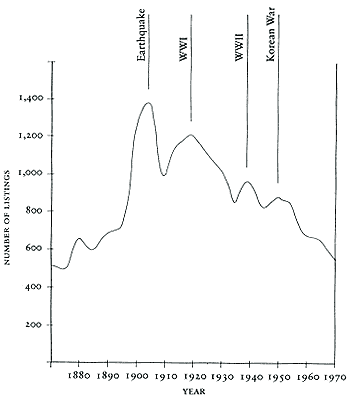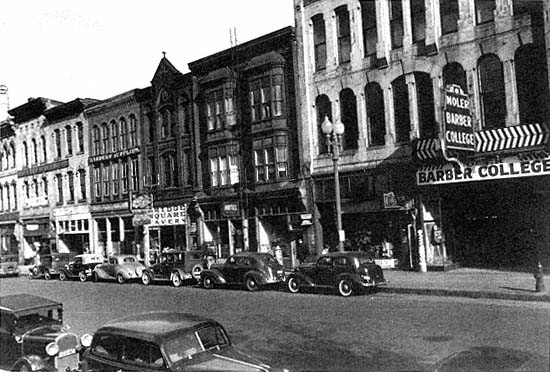Cycles of Investment and Construction
Particular years were noted for surges in all types of hotel investment. San Francisco directories record how quickly the number of hotels changed in response to potential business (fig. 6.8). Peaks of hotel listings coincided with surges in the local and national business climate, particularly in response to increased industrial and office employment, wars or other widespread investment stimuli, and surges in tourist travel. Troughs in the number of hotels corresponded to employment and travel slumps.[27]
Mercantile and industrial expansion—and the ensuing population movement—triggered good business for hotels of all types. The first major peak in San Francisco's hotel listings, from the mid-1890s to 1905, followed production surges for the Spanish-American War, discovery of gold in the Klondike, and increasing Philippine and Pacific

Figure 6.8
Graph showing total number of hotel listings in the San Francisco
directories from 1870 to 1970.
Basin trade. It also coincided with the stimulation of Pacific Coast business due to the promise of the new Panama Canal trade and the rapid growth of population and markets in the American West.[28] San Francisco's great earthquake and fire of 1906 only briefly interrupted hotel business. In the aftermath, a great many hotels were built for workers and for households displaced by the destruction. No drastic land-use changes occurred in the rebuilding; the fire merely hastened and highlighted gradual developments already under way in real estate investments for the center section of the city.[29] At the scale of individual lots, the average hotel business before the fire had about 30 to 60 rooms; after the fire, each business listed in the directory was more likely to be on a lot twice as large and to have from 40 to 100 rooms.[30] Thus, although the number of individual hotels in San Francisco peaked in 1906 (the year of the fire), the peak in hotel rooms came after World War I.
Hotel keeper E. M. Statler called World War I "the best five years American hotels ever had." (He could not have imagined the boom of
World War II.) Wartime meant expanded employment. New hotels of all ranks were built or converted for war demands, and each wartime boom stretched all existing hotels to their maximum potential—and sometimes beyond. War industry workers packed into lodging houses and rooming houses while the better hotels did thriving business with war-material brokers, production engineers, government officials, and military officers. The only single-room housing operations that languished in World War I were the free municipal lodging houses and other flophouse adjuncts in some cities, which were made less necessary by high wartime employment. The Chicago Municipal Lodging House closed entirely in 1918 –19 because of lack of applicants.[31]
After World War I, generally, only the directors of philanthropic rooming houses (such as new YWCAs) and owners of midpriced and palace hotels added to the stock of hotel rooms. Again, the San Francisco case is typical.[32] From 1918 to 1921, manufacturing employment decreased in San Francisco industries by 4,000 employees, down almost 10 percent; by 1925, it had dropped by another 4,000. Hence, private downtown housing investors in San Francisco built neither lodging houses nor rooming houses after World War I. A share of this downtown decline also resulted from mechanization in the work place and the steady relocation of industries to the edge of the city.[33]
Within these broad swings in hotel business, several market processes operated. Perhaps the least rational were those behind the building of palace hotels and some midpriced hotels. Beginning in the 1820s, each generation of city business leaders felt compelled to adorn their town with a state-of-the-art hotel—usually larger and more lavish than strictly necessary—to assure their city's regional or national stature. In the 1920s, palace hotels began to vie even with office skyscrapers as the largest buildings in major cities. Not all of this was sheer boosterism. For two centuries Americans have responded positively to size in hotels as they have responded to size in other commercial attractions. The biggest hotel in town also commanded monopoly rates and the largest conventions.
In the battle between city boosters in different towns and between different expensive hotels, design and fashion as well as size figured prominently. As the competition between a city's better hotels increased, the owners and managers came to rely more on the tools of high-style design, attention-catching interior decorating, spectacular
cooking, and innovative engineering. In every generation, owners and their architects informally settled on a prevailing facade style for hotels; for interiors, managers and their designers changed the reigning style almost twice as often. Thus, to remain in fashion, hotel managers had to search for better chefs constantly, redecorate about every ten years, and significantly remodel or add new wings at least once every twenty to twenty-five years. Watching the constant competition between grand hotels, Sinclair Lewis observed that "next to love, nothing loses its rank so quickly as a leading hotel."[34]
When hotel owners demanded ever-larger hotels to pay for evermore-expensive downtown land, architects responded with new types of floor plans. On larger sites, designers provided wings of rooms separated by larger and wider light wells. In an "E" or "C" shape, the floor plans yielded more rooms with two- and three-way exposure for better cross-ventilation and light. Engineering also set new hotel fashions. For every passing decade's conspicuous innovative gadget—calling-card elevator, exuberant lighting display, ice water tap, or built-in radio—managers installed many more machines to reduce labor costs. By 1900, the design and outfitting of hotels had become complex enough so that a few architecture and engineering firms specialized in hotel design and did a significant share of the nation's large hotel business.[35]
The use of elevators particularly revolutionized hotel life. With elevator access, the rooms on upper floors (once the cheapest rooms) became the most expensive. By the 1920s, tower views from high palace hotel rooms had become another aspect of hotel living that expensive private houses could not outdo.[36] In San Francisco, it was George Smith who best captured the skyscraper view. In 1939, to compete with new post-Prohibition bars and nightclubs opening throughout the city, he opened the Top of the Mark at the remodeled crown of his hotel, where a penthouse apartment had been. Smith also hired the talented architectural office of Timothy Pfleuger to give the Top of the Mark the Manhattan sheen of Art Deco style.[37]
Managers who chose not to compete in the size, chef, or gadget game typically dropped their hotels to a lower rank of clientele by cutting the amount of service, closing lavish dining rooms, or changing from American plan to European plan rates. With such cuts in service, a palace hotel could be profitably run as a midpriced hotel. In the late 1920s, so many boosters had built so many good hotels that in most cities

Figure 6.9
The Gateway District of Minneapolis, photographed in 1939. Through the filtering of clients, this Victorian
midpriced hotel district had shifted to cheap lodging house status.
there were price wars and substantially lower transient occupancy rates. Simultaneously, motels and auto courts were beginning to cut into the family travel market. Such overbuilding stimulated more permanent occupancy to fill the rooms. Managers lured tenants with ads proclaiming, "Occupancy from October! Lease from January! Fifteen months for the rent of twelve."[38]
For all types of hotels, shifts of social cachet, demographic changes in surrounding neighborhoods, or losses in nearby employment triggered the process of filtering: first, former permanent guests gradually filtered out to newer, more comfortable, or better-located quarters; second, to keep occupancy levels high, managers at the older hotels lowered their prices, allowing less affluent tenants to filter in; finally, the remaining earlier tenants left, feeling that their social standing, comfort, or safety was in jeopardy. In any American city, it was not unusual in the 1920s to see handsomely designed and fashionable family hotels of the 1880s that had devolved to inexpensive rooming houses for unskilled or unemployed workers.[39] Cheaper hotels, too, filtered to lower-income tenants (fig. 6.9). In the core of San Francisco's South of Market
district, the managers of several hotels built in 1906 had by 1919 discontinued polite hotel services and given up the term "hotel"; they simply ran their establishments as more casual rooming houses or lodging houses. On one block alone, three out of four hotels had seen this conversion.[40]
To maintain high profits in spite of lower rents, owners of rooming or lodging houses could reduce repair budgets and employ only minimally skilled managers or staff. What observers called the "visual decay" of rooming house districts was usually the evidence of inept or uncaring management and the literal erosion of architectural fabric: first cosmetic facade deterioration and then more serious structural dilapidation from decreased maintenance.[41]
Like the question of when to launch a new hotel business, the question of when to leave the hotel business was often prompted by the general urban metabolism and how it affected the neighborhood, hotel clientele, competition for the hotel site, and the cash flow of the property owner(s). If hotel managers could not sell their rooms to either tourists or permanent guests, and if shifting to cheaper clients did not work, owners often looked to office rentals or other nonhotel uses. At appropriate downtown locations hotel owners could rent rooms, whole floors, or the whole hotel as offices. Even in colonial times, hotels had mixed offices and sleeping rooms. In 1906, the Grand Central Hotel in San Francisco was consciously built to be either office or hotel space, and it saw both uses. The elegant Hotel Whitcomb served as San Francisco's city hall for a time after the great fire. About 1920, the owners of New York's Manhattan Hotel (even though it was the birthplace of the Manhattan cocktail) converted the twenty-four-year-old building to offices. Other hotel owners converted their properties to private hospitals (or vice versa). After 1945, however, demands for better electrical service, lighting, and air-conditioning made such office and hospital conversions less feasible.[42] When all else failed, a major old hotel's downtown site usually brought the owners a good price as the location for a new office tower. The most notable example of such conversion is the block that held the original Waldorf-Astoria Hotel, where the Empire State Building now stands. At times even perfectly profitable and viable hotels were torn down, revealing tensions that can exist between owners and managers. If the owners were convinced they could profit
more by closing the hotel and changing the building's use—and if the managers had lost their lease—no basis remained for the hotel to be in business, other than emotional appeals by the managers or clients.
Especially at the scale of the Empire State Building but also at more modest sites, the actions of individual owners and managers had a great influence on the surrounding blocks. Hotels collected large numbers of people who were a market for other retail services nearby. The hotel's staff also exerted a pressure for their own housing and for their retail needs. These influences, plus their voice in urban governance as landowners, gave hotel builders important roles in rebuilding downtown neighborhoods in a more organized way.